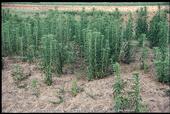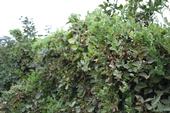- Author: Steve Orloff
- Posted by: Gale Perez
From the Alfalfa & Forage News blog :: Feb. 18, 2013
Dodder is a troublesome annual parasitic weed that infests alfalfa fields. Initial infestations are usually caused by sowing dodder infested seed (a good reason to purchase Certified seed) and by “sheeping off” fields with sheep that came from an infested field. Perhaps no weed problem is worse than an alfalfa field heavily infested with dodder. As a parasite, it lives at the expense of the alfalfa plant and literally sucks the vigor and life out of the plant. If left uncontrolled it can actually kill the alfalfa plant. It emerges as a rootless shoot and must...
- Author: Kurt J. Hembree
- Posted by: Gale Perez

While both horseweed and hairy fleabane have been here since farming began in the region, it's only since about 2003 that they have become such an obvious problem, particularly in tree and vine systems and non-crop areas.
In the past, the traditional use of combinations of pre- and postemergence herbicides and/or cultivation was adequate to manage them. However, recent changes in environmental regulations, economics, herbicide use patterns (toward more postemergence-only programs), treatment timing, and glyphosate-resistant biotypes have all contributed to the problem. Other factors contributing to their spread include, high seed production, wind dissemination, lack of seed dormancy requirement, preference for undisturbed areas...
- Author: Mark Bolda
- Author: Steven Fennimore
- Author: Patrick Kingston
- Posted by: Gale Perez

From the UC Strawberries and Caneberries blog :: Sept. 11, 2013
Field bindweed, Convolvulus arvensis, also known locally as morning glory, is a persistent weed pest in blackberries grown on the Central Coast of the California. Much of this stems from the long period of time between plant establishment and final removal of the crop some five to six years later.
While cultivation of the aisles between the hedgerows is successful in keeping the field clear of most weeds, field bindweed is another matter. Not only does field bindweed establish very deep root systems which frustrate control by cultivation, but...
- Author: Michelle Leinfelder-Miles
- Posted by: Gale Perez
From the Alfalfa & Forage News blog :: Oct. 25, 2013
Written by Michelle Leinfelder-Miles
At the Alfalfa and Forage Meeting held at the Kearney Agricultural Center in September, we provided a demonstration of the co-existence of Roundup Ready® (RR) and conventional alfalfa hay fields. The demonstration took place between two hay fields – one of them RR and the other conventional – that were in their third year of production and separated only by a one-lane dirt...
- Author: Gale Perez

From the ANR Report :: February 2014 :: Vol. 27 No. 8 (http://ucanr.edu/sites/anrstaff/newsletters/ANR_Report50615.pdf)
Brad Hanson, UCCE specialist in the Department of Plant Science at UC Davis, has received national and statewide recognition by his peers. He was named Outstanding Early Career Weed Scientist by the Weed Science Society of America. The award is reserved for scientists who have held their terminal degree no more than 10 years and have...


